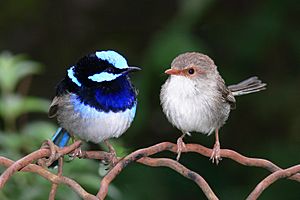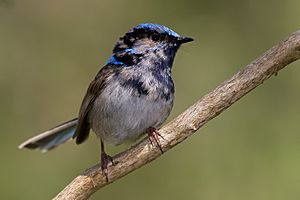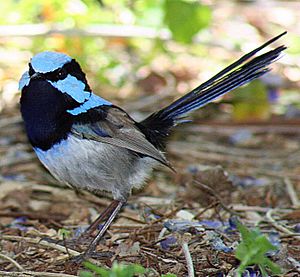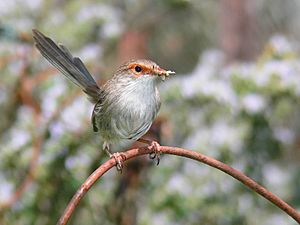Superb fairywren facts for kids
Quick facts for kids Superb fairy-wren |
|
|---|---|
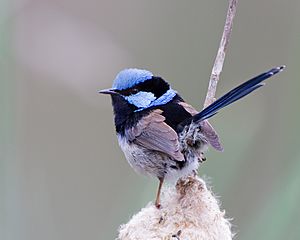 |
|
| Male in breeding plumage subspecies cyaneus |
|
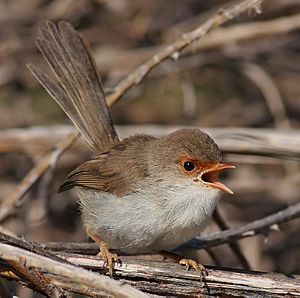 |
|
| Female – Victorian high country | |
| Conservation status | |
| Scientific classification | |
| Kingdom: | |
| Class: | |
| Order: | |
| Family: | |
| Genus: |
Malurus
|
| Binomial name | |
| Malurus cyaneus Ellis, 1782
|
|
| Subspecies | |
|
|
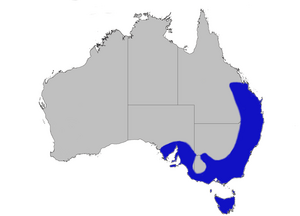 |
|
| Superb fairywren range
M. c. cyanochlamys; M. c. cyaneus
|
|
The superb fairywren (Malurus cyaneus) is a small passerine bird. It belongs to the Australasian wren family, Maluridae. This bird is very common in south-eastern Australia.
Male superb fairywrens in breeding season are very colorful. They have bright blue feathers on their forehead, ears, back, and tail. They also have a black mask and a black or dark blue throat. Males not in breeding season, females, and young birds are mostly grey-brown.
There are six types of superb fairywrens, called subspecies. Three are larger and darker, found on islands like Tasmania. The other three are smaller and paler, found on mainland Australia.
Male wrens do a special dance to attract females. They even pick yellow flower petals and show them off!
You can find superb fairywrens almost anywhere with dense bushes for shelter. This includes grasslands, forests, woodlands, and even home gardens. They have adapted well to city life. They are common in places like Sydney, Canberra, Adelaide, and Melbourne. Superb fairywrens mainly eat insects. They also eat some seeds.
Contents
About the Superb Fairywren
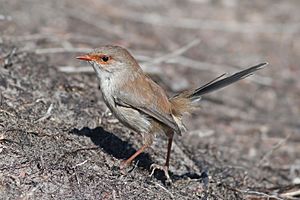
The superb fairywren is about 14 cm (5+1⁄2 in) long. It weighs between 8–13 g (0.28–0.46 oz). Males are usually a bit bigger than females. Their tail is about 5.9 cm (2+1⁄3 in) long. This is one of the shortest tails in their bird group.
Their beak is long, narrow, and pointed. It is about 9 mm (0.4 in) long. This shape helps them find and pick up insects.
Superb fairywrens show strong sexual dimorphism. This means males and females look very different. Breeding males have bright, shiny blue feathers. These colors stand out against black and grey-brown parts. The bright blue on their head and ears is important for their mating dances.
Breeding males have a bright blue forehead, ear feathers, back, and tail. Their wings are brown. Their throat, eye band, chest, and beak are black. Females, young birds, and non-breeding males are plain fawn (light brown). Their belly is lighter. Their tail is fawn or dull greyish blue.
Female and young birds have brown beaks. Males have black beaks after their first winter. Young males get their full breeding colors over a year or two. Both sexes lose their old feathers in autumn after breeding. Males then have duller, non-breeding feathers. They get their bright breeding feathers back in winter or spring.
The blue feathers of breeding males are very shiny. This is because of how their tiny feather parts are shaped. This blue color also reflects ultraviolet light strongly. Other fairywrens can see ultraviolet light. So, the blue might look even brighter to them!
Bird Calls and Sounds
Superb fairywrens use their voices to talk to each other. They also use calls to warn about dangers or defend their area. The basic song is a fast, high-pitched sound. It lasts 1 to 4 seconds. Both males and females sing this song.
Males also have a special song-like call. They make this sound when they hear birds that hunt them, like grey butcherbirds. It's not a warning call for other wrens. In fact, it can show the predator where the male is. Scientists are still trying to understand why they do this.
Their alarm call is a series of short, sharp "chit" sounds. Many small birds understand this call when predators are near. Females also make a soft "purr" sound when they are sitting on their eggs. These birds might also use calls as a "password" for their chicks. This helps them avoid cuckoo birds, which lay their eggs in other birds' nests.
Where Superb Fairywrens Live
The superb fairywren is common in the wet, fertile south-eastern part of Australia. You can find them from South Australia to Victoria, Tasmania, and along the coast of New South Wales and Queensland. They are common in cities like Sydney, Melbourne, and Canberra.
They live in wooded areas that have lots of bushes. They have also learned to live in cities. You can find them in gardens and parks if there are native plants nearby. Some invasive plants, like lantana and blackberry, also give them shelter.
Unlike some other fairywrens, they seem to do well in cities. One study in Canberra showed they even did better than the introduced house sparrow. You can find groups of wrens in Hyde Park and the Royal Botanic Gardens in Sydney. They do not live in very dense forests or cold mountain areas. Pine and eucalyptus tree farms are also not good for them because they lack bushes.
Superb Fairywren Behavior
Like all fairywrens, the superb fairywren is always busy looking for food. They often search on open ground near bushes. They also look for food in the lower leaves of plants. They move by hopping and bouncing. Their long tail helps them balance. The tail is usually held straight up and is rarely still.
Their short, round wings help them take off quickly for short flights. They are not good for long flights. In spring and summer, they are active in bursts during the day. They sing while they look for food. Insects are easy to find then, so they can rest between hunts. The group often rests together during the hottest part of the day. In winter, food is harder to find. They have to spend all day looking for it.
Superb fairywrens are cooperative breeding birds. This means pairs or groups of 3 to 5 birds live together. They protect their small area all year. The group usually has a main pair and one or more helper birds. These helpers were born in the area. They might not be the main pair's children. These helper birds help defend the area and feed the young. Birds in a group sleep close together in thick bushes. They also groom each other.
Many animals hunt superb fairywrens. These include Australian magpies, butcherbirds, laughing kookaburras, currawongs, crows, ravens, and shrike-thrushes. Introduced animals like red foxes, cats, and black rats are also predators.
Superb fairywrens have a special trick to distract predators from their nests. It's called a 'rodent-run' display. The bird lowers its head, neck, and tail. It spreads its wings and fluffs its feathers. Then it runs very fast while making a loud alarm call. This makes the predator chase the bird instead of finding the nest.
A study in Canberra found something interesting. Superb fairywrens living near noisy miner birds learned to understand miner alarm calls. They would fly away when they heard them. But they ignored the miner's normal calls. Wrens not living near noisy miners did not react to their alarm calls. This shows that fairywrens can learn to understand other birds' calls.
Courtship and Mating
Male superb fairywrens have several ways to attract females. One is the 'sea horse flight'. The male flies up and down like a seahorse. He stretches his neck and raises his head feathers. He tilts his body and slowly goes down. Then he springs up by flapping his wings fast.
Another display is the 'face fan'. The male flares out his blue ear feathers. This can be a sign of aggression or to attract a mate.
During breeding season, males pick yellow flower petals. These petals stand out against their blue feathers. They show these petals to females. The petals are often part of a courtship display. Males sometimes show petals to females even outside of breeding season. They might do this to show off how good they are.
Reproduction and Life Cycle
Superb fairywrens breed from spring to late summer. Their nest is round or dome-shaped. It is made of loosely woven grasses and spider webs. The entrance is on one side, usually close to the ground (under 1 m (3.3 ft)) in thick plants. They can have two or more groups of babies in one breeding season.
A female lays three or four matte white eggs. The eggs have reddish-brown spots. They are about 12 mm × 16 mm (0.47 in × 0.63 in) in size. The eggs hatch after 14 days. All eggs usually hatch within 24 hours.
Newborn chicks are blind, red, and have no feathers. They quickly get darker as their feathers grow. Their eyes open around day five or six. They have all their feathers by day 10. All birds in the group help feed the chicks. They also remove waste for 10 to 14 days.
Young birds can feed themselves by day 40. But they stay with their family group as helpers for a year or more. Then they might move to another group or become a main bird in their own group. As helpers, they feed and care for new babies. They also help chase away cuckoos or predators.
Superb fairywrens are often tricked by Horsfield's bronze cuckoos. These cuckoos lay their eggs in the fairywrens' nests. Less often, shining bronze cuckoos and fan-tailed cuckoos also do this.
What Superb Fairywrens Eat
Superb fairywrens mostly eat insects. They eat many kinds of small creatures. These include ants, grasshoppers, shield bugs, flies, weevils, and different larvae (young insects). They also eat small amounts of seeds, flowers, and fruit.
They search for food by hopping on the ground or in bushes less than two meters high. Because this way of finding food makes them open to predators, they usually stay close to cover. They also look for food in groups. In winter, when food is harder to find, ants become a very important food source.
Baby birds (nestlings) eat bigger insects. These include caterpillars and grasshoppers.
Superb Fairywrens in Culture
The breeding male superb fairywren is a symbol for the Bird Observation & Conservation Australia group. On August 12, 1999, a superb fairywren was accidentally put on an Australia Post stamp. It was supposed to be a splendid fairywren. Before that, it was called the blue wren. It was on a stamp in 1964, but that stamp was stopped when Australia changed its money system.
Images for kids
-
A pair on a garden birdbath in New South Wales, Australia
See also
 In Spanish: Maluro soberbio para niños
In Spanish: Maluro soberbio para niños



